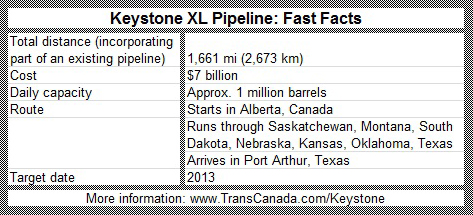WASHINGTON — Saturday is the kickoff of what organizers are billing as possibly the largest civil disobedience action in the history of the American environmental movement.
From Saturday to Sept. 3, protesters are expected to stage sit-ins in front of the White House to encourage President Barack Obama to deny a permit for the Keystone XL oil pipeline.
More than 2,000 people have signed up to come to Washington to participate, though that number may still increase over the next couple of days.
The pipeline, which would run from Alberta, Canada, to Texas, is controversial because it would import a kind of oil called oil sands or tar sands. Environmentalists say oil sands petroleum is more corrosive than regular oil because of its higher sulfur content, which they fear would cause more leaks in the pipeline and be devastating to the environment if it spilled.

TransCanada hopes to build a pipeline to bring oil sands to refineries in Texas. (Alexandra Arkin / MNS)
The pipeline’s opponents also say oil sands petroleum has a higher carbon footprint than other oils because of the environmental impact of its production, which involves piping steam through the sands to release the oil, leaving enormous waste pits behind and using a large amount of energy in extraction.
Tar Sands Action, the group planning the protest, calls the oil sands in Alberta “the largest carbon bomb in North America.”
TransCanada and the American Petroleum Institute — the American oil and gas industry trade association — cite studies saying oil sands petroleum is no more corrosive than the oil the U.S. has used for years.
TransCanada will use the newest technologies to prevent leaks in the pipeline expansion, according to TransCanada spokesman Terry Cunha, including burying the pipe deeper than the industry requires and using a thicker pipe in environmentally sensitive areas. It will monitor the pipeline continuously using satellites and 16,000 sensors along the pipeline, and be able to shut down the system if the sensors detect a leak.
TransCanada filed a proposal with the State Department to build the pipeline in 2008. A final draft of the State Department’s Environmental Impact Statement is expected this month. The release of the final study will be followed by 90 days of consultation with federal agencies about whether issuing a permit for the project would be in America’s national interest.
In September, the State Department will host public meetings in the six states through which the pipeline would pass, and Washington, D.C. Three months later, it will make a final ruling on the permit. If other agencies object, Obama would make a final decision.
Realizing that the president can stop the pipeline’s construction prompted Ripton environmentalist and author Bill McKibben, founder of the grassroots climate campaign 350.org, to organize a protest at the White House.
“He (President Obama) has to sign the necessary permit, and Congress can’t get in his way as they so often have,” he said.
“We’ll be outside his house less to protest than to show our support for him acting with the boldness and decisiveness he promised in his 2008 campaign,” McKibben said. “He proclaimed, the day he was nominated, that with his arrival ‘The rise of the oceans would begin to slow and the planet begin to heal.’ This is his opportunity to show that he meant it.”
Sen. Bernie Sanders, I-Vt., has voiced his support of the sit-ins.
Opponents of the pipeline say the State Department’s analysis of the pipeline’s environmental impact has been inadequate, and further review, including alternative pipeline routes, is needed.
McKibben added that he thinks the project has been wired politically in the State Department.
“It’s no accident (TransCanada) hired (Secretary of State Hillary) Clinton’s former deputy (presidential) campaign director as its chief lobbyist,” he said, referring to Paul Elliott, who is TransCanada’s lobbyist in Washington.
The oil and gas industry says the review has been comprehensive.
“The State Department’s analysis hasn’t led to huge cause for concern about environment,” said Cindy Schild, a refining manager for the American Petroleum Institute. She called the three-year evaluation of the proposed pipeline “unprecedented.”
Schild said she hopes the plan is approved because of the jobs it will create, in addition to the oil it will provide the U.S.
While he hopes the protests will influence the president’s decision, McKibben says he has no clue what will result.
“I’m deeply curious to find out. I think it’s the biggest single global warming decision that Obama’s gotten to make, except perhaps for his decision to punt on the Senate climate bill.”
The White House was unavailable for comment on the protest.
